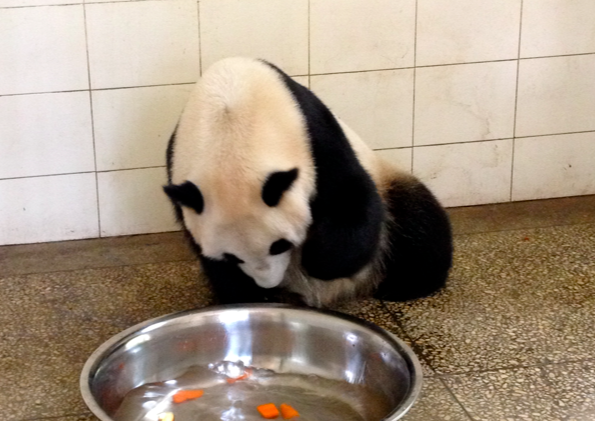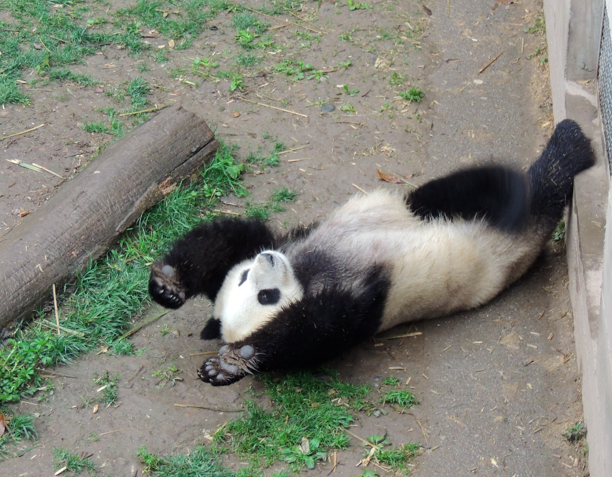Since starting the personality studies, I’ve noticed that each panda approaches the enrichment items differently. I’ve seen pandas swat at the basketball or pick the ball up to hold it, and I’ve seen a panda place her paw on a piece of ice and rub it back and forth across the floor (kind of like a child does with a toy car). However, I’ve also seen the complete opposite where they ignore the object altogether or seem upset that there is something unfamiliar in their cage (usually a combination of both). I didn’t really think any of the behaviours that I had observed were out of the ordinary because introducing pandas to unfamiliar items could influence any number of reactions considering the wide range of individual personalities that I’ve noticed. However, while studying Su Lin’s personality this week, I can say that she’s a truly exceptional panda!
For one of the enrichment trials, I pour water into a huge bowl until it reaches a few inches from the bottom and then I put apple and carrot pieces in the water for the pandas to catch and eat. Generally, the pandas smell around the bowl and hesitate before putting their paws in, but once they realize it’s just water, they chase a slice of apple or piece of carrot around with their paw, grab it, then eat it. When I opened the door to her enclosure, Su Lin took a few minutes to come inside (she was interested in something outside). However, once she came inside, she seemed to know what to do! She walked over to the bowl and pushed it with her paw then she picked up one side and dropped it (splashing water everywhere!). She quickly decided to shove her paw in and started to scoop out the water. I don’t think taking the water out of the bowl was working quite as well as she thought it would, so she dug out the apples and carrots super quickly while continuing to splash water everywhere. I was amazed with how quickly she managed to get all of the food items out of the bowl! Once she had eaten all of the food items, she lost interest in the bowl with water in it. But, about half an hour later, she returned to the object and decided to have another look. She smelled around the edge of the bowl, then grabbed one edge and poured the whole bowl of water out onto the floor of her enclosure. She searched the water to make sure that she didn’t miss any food, and then she pushed the empty bowl around her enclosure for a bit. I was expecting one of the pandas to eventually empty the bowl in search of food, but I was surprised at how many of them didn’t even attempt to lift it. Su Lin was the 4th panda to get this enrichment item, but she was the quickest to retrieve all of the food items and the first one to actually try to remove the water from the bowl/pour the water out.


Yesterday, she received a basketball. The basketball has been introduced to 5 pandas and most of them have only been somewhat interested in it. Usually, they smell it and sometimes paw it, but most of them don’t seem to find the ball very interesting. Su Lin took the basketball and rolled it, but watching her follow the ball around reminded me of my dog with her “Tricky Treat Ball”. A “Tricky Treat Ball” is a ball that you can fill with treats, and in order to get the treats, your dog has to roll the ball around until a treat falls out of the ball. Su Lin was interacting with the basketball like a Tricky Treat Ball. She would push it with her head or paw then look around where the ball had rolled in search of food. I have only seen this behaviour in Su Lin (so far) and I wish I had been able to get a video of her doing this, because there was really no mistaking that she was expecting the ball to dispense food.
Su Lin was born at the San Diego Zoo in 2005 and was moved to the Bifengxia panda base in China in 2010. While at the San Diego Zoo, I’m almost certain that she would have been given an enrichment item that involved manipulation in order to receive food. While she didn’t get any food out of the basketball, I found this behavior very interesting for a number of reasons. Probably the most remarkable of which is that she likely hasn’t seen an enrichment item similar to the one that she may have been given at the San Diego Zoo in about 2.5 years. If she has even seen a ball in the past year, it likely would have been a basketball used by Arina for last year’s personality study and not a food-dispensing enrichment item. Yet, she still associated a highly manipulable object with food and performed behaviours that she thought would allow her to gain access to food.
In addition to this, I’d like to add the Su Lin is the only panda that has not shown any stereotypic behaviour in either her morning or afternoon observations for our stereotypic study (although Feng Yi also didn’t show any stereotypic behaviour during her morning assessment, her afternoon assessment has yet to be completed).
From watching Su Lin, I can say that not only do I believe bears have good long-term memories, but judging by her lack of stereotypic behaviour, I also believe that being provided with enrichment during her ‘cubhood’ has had long-lasting positive effects on her behaviour – even years after leaving San Diego.
-Steph



Hi, Meg–very interesting information. Su Lin was certainly exposed to treat balls at SDZ, both before and after her weaning from Bai Yun. And she would have seen Bai retrieve food from frozen “cakes” and toys or other objects from tubs or the pond. I’m curious about the “stereotypic” behavior you mentioned–do you mean things like pacing? Bai Yun certainly paces when she thinks her food is late or she wants to go inside. Do you mean that stimulation during Su Lin’s cubhood helps her interact with her surroundings and, in a sense, amuse herself, so that she doesn’t become frustrated or bored? Thanks so much for your insights and the news about the SDZ “returnees.”
Frances
Frances,
Thanks for the information! As regarding the stereotypic behavior; in the science world we describe stereotypical behaviors as behaviors that are repeated in sequence three or more times (usually much more!). These behaviors can range from pacing (the most commonly though of stereotypical behavior) to tongue flicking. We see a variety in the pandas such as somersaulting in patterns, vocalizations (like chirps repeated over and over), etc. Most scientists believe that stereotypes exist because animals are frustrated and/or can’t perform certain natural behaviors – though this is widely argued in scientific literature too. Stereotypes do seem to be associated with increased levels of cortisol indicating that they may signal higher stress in animals. Scientists know that animals that are raised with environmental enrichment are less likely to have stereotypical behavior as adults which is why we postulated Su Lin may not have stereotypes as San Diego Zoo has an awesome environmental enrichment program. Of course, all of these topics are being researched and we are still trying to figure out their roles in zoo animals! Hopefully, my research will help shed some light on how stereotypical behavior may be effecting reproductive success.
As always thanks for your thoughtful comments!
Meg
As always, Meg–thank you for answering! I know I’ve heard of other animals–such as polar bears–being prone to stereotypical behaviors, so I guess it isn’t surprising that captive pandas would be too. Gao Gao does that tongue flicking behavior, which he seems to have done even while he was young and in China. It doesn’t seem to have affected his reproductive success! Certainly if those behaviors do indicate stress or unhappiness in some animals, it would seem quite logical that their reproductive success might be hindered.
I am curious as to whether animals like Su Lin and Zhen Zhen, who have been raised with lots of enrichments, become bored when they don’t have them.
Thanks again!
I don’t know if they become bored – what a great question! I think much research has been done on raising animals in enriched environments but not what happens when they get transferred to an environment that may not have these outlets. However, the CCRCGP has such large enclosures (many are 1-2 acres) with so much natural stimulation as well as climbing and water structures that it doesn’t seem to have effected Su Lin or Zhen Zhen, neither have stereotypical behaviors similar to other animals here. The stereotypical behavior question is such and interesting question and has so many inputs, I suspect we won’t fully know what’s happening and how they develop for some time.